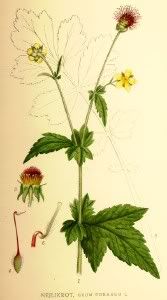

Avens (Geum urbanum, G rivale)
Folk Names: Assarenaccara, Bennet, Blessed Herb, City Avens, Clove Root, Colewort, European Avens, Gariophilata, Geum, Golden Star, Goldy Star or Goldy Star of the Earth, Harefoot, Herb Benedicta, Herb Bennet, Minarta, Pesleporis, Star of the Earth, Way Bennet, Wild Rye, Yellow Avens; G rivale: Cure All, Drooping Avens, Indian Chocolate, Nodding Avens, Purple Avens, Water Avens, Water Flower
Description: Avens is a perennial of the rose family. Growing near hedges, fences, walls, it likes deciduous forests and shady places. The root may be one to three inches in length, finger-thick, yellow-brown outside and pinkish to pink-violet inside. The wiry, erect, hairy stem is red at the bottom, branches slightly, and may be one to two feet tall. The lower leaves are lyrate and pinnate, while the upper ones are ternate or trifid. The leaflets are broadly ovate and serrate. From June to August and as late as December, bright yellow, drooping flowers grow from terminal stalks. Each flower has five petals, and a calyx segmented into ten sections.
Geum rivale has a reddish purple or brownish root, and the stem is rarely more than a foot high. The leaves are lyre-shaped, with irregular compound basal leaves each with a broad terminal segment. The upper leaves have three lobes. From May to August, flowers grow, often in clusters of three. The flower is larger than regular avens and is bell-like, brownish purple to yellowish. The fruits are hooked with bristly hairs.
Effects: strong
Planet: Jupiter
Element: Fire
Associated Deities:
Traditions:
The name geum originated in the Greek word, geno, to yield an agreeable fragrance. When freshly dug up, the root exudes a clove-like aroma. This in turn gave rise to the name Clove root or Radix caryophylata. The root was usually harvested in the spring, specifically on March 25th, Lady’s day, when the root was thought to be most fragrant. Unfortunately, it loses much of its scent as it dries.
Magic:
Avens is said to keeps away devils, demons, evil spirits, and negativity. It may be carried as a protective amulet, and guards against all venomous beasts and poison. It may be employed in exorcism incenses and mixtures. Sprinkle around the area to be exorcized and use it in purification rites.
According to some Native American tribes, avens may be used to gain the love of the opposite sex.
Known Combinations:
none noted
Medical Indications: Parts Used: root, flowering herb
Avens has been used in the past to dissolves internal blood clots. It is an astringent suitable for diarrhea, or as a gargle for gum problems and halitosis. A wine extract of the herb promotes appetite and digestion in older people and acts as a tonic during convalescence. It can be used for chronic bronchial catarrh and intermittent fever. Indian chocolate, named for its color not flavor, is made from the roots and leaves of G rivale, water or milk, wine, and sugar.
Nutrition:
none noted
Mercantile Uses:
In early times, avens was used to flavor ale, and to defend linens against moths. Augsburg ale, in particular, is known for the use of avens in its creation.